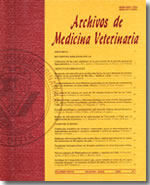Isolation, identification, and antimicrobial susceptibility of Brucella spp. cultured from cows and goats manure in Mexico
Main Article Content
Abstract
Brucellosis is a zoonosis that affects many animal species worldwide. Humans are often infected through direct animal contact, through contact with animal excretions, or through ingestion of unpasteurized dairy products. Livestock manure is extensively used as a pasture fertilizer in many production systems, especially in non-developed countries. Some microbiological studies warn of the risk of manure being a disseminator vector of pathogenic microorganisms. The present study aimed to isolate Brucella in manure from cows and goats that were serologically positive for brucellosis in an endemic region of Mexico. We then used E-test methods to evaluate the isolated microorganisms' susceptibility to antimicrobial agents in vitro. Brucella isolation was performed via a pre-enriched selective culture, and subcultures using selective agar plates. Isolates were identified using microbiological tests as well as BCSP31 PCR and Bruce-Ladder multiplex PCR. We isolated 10 Brucella spp. strains, all of which amplified the genus-specific gene that encodes the BCSP31 protein. The species were identified using multiplex PCR. Interestingly, B. melitensis, B. abortus, and B. suis were isolated from cow manure, while B. abortus was just isolated from goat manure. The isolates did not include any strains that are routinely vaccinated against. Some isolates were resistant to ciprofloxacin, levofloxacin, trimethoprim-sulfamethoxazole, and rifampicin. Manure from infected animals could represent a vehicle for human exposure to Brucella. More detailed studies are needed to evaluate Brucella-contaminated manure as a risk factor in endemic regions.

